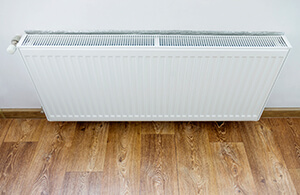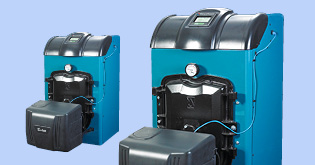- My Account:
- Sign In
- Register
- Make Payment

Steam radiator vs. forced hydronic baseboard boilers.
Do you heat your home with a boiler? Are you unsure whether you have a steam boiler or forced hydronic boiler? Understanding the type of heating system you have can be incredibly helpful for scheduling home maintenance services. This simple guide will clarify the difference between a hydronic vs. steam boiler.
Steam radiator.
If you have a steam boiler, your home is warmed using convection heating technology that dates back over 200 years. A steam boiler operates similarly to a tea kettle, in that it heats water to a boil until hot steam is released. The inherent pressure behind the steam forces it to move through the piping system. When the steam arrives at each radiator in your home, it releases convective heat to warm the room.
Steam boilers feature basic controls to ensure the safe, correct operation of the system. These include:
Pressure control: This allows pressure to build to the desired setting. this safety device shuts the burner down if pressure surpasses the pressure setting.
Temperature and pressure (T&P) relief valve: This failsafe only kicks in if the pressure gauge/regulator fails and the pressure builds to a dangerously high level. When activated, the pressure relief (pop safety) valve releases steam so the system doesn’t rupture explosively.
Water level gauge glass: This is a glass tube that shows the water level inside the boiler.
Low water cutoff: Because steam condenses and returns to the boiler to be reheated, the system shouldn’t run out of water. However, if there’s a leak in the system, the water level may drop. If this happens, the low water cutoff feature shuts down the boiler as a safety precaution.

How to know if you have a steam boiler in your home: Start by visiting the basement, closet, or utility room where the boiler is located. Check for a gauge glass to determine if you have a steam system or not. Since hydronic baseboard heaters don’t have this feature, its presence tells you this is a steam boiler.
Another defining characteristic of steam boilers is the type of radiators it uses. Occasionally, homes with steam boilers will have baseboard heaters, but most of the time, freestanding cast-iron radiators in each room indicate a steam system.
Baseboard boilers (forced hydronic).
Another common type of residential boiler is called a forced hydronic boiler. This transfers heat to your home using a more efficient method than steam boilers.
- Instead of keeping the water in the boiler itself and transferring the heat via steam, it heats up the water, circulates it through a pump, and sends the water flowing into distribution piping.
- The water radiates heat through a heat emitter, such as steel or fin-tubed baseboard, and then it returns to the boiler to be reheated.

Forced hydronic boilers don’t only work with baseboards – you can also use them in radiant floor heating systems or to heat towel rails, swimming pools, and driveways to melt snow. These modern comforts can be individually adjusted to achieve the perfect temperature in every application.
Contemporary hydronic technology is highly efficient and delivers heat precisely where you want it, making it a common feature in high-end homes.
How to know if you have a forced hydronic boiler: Check the heat distribution method. Older homes with a hydronic system may have a cast-iron radiator in the basement, but modern forced hydronic systems usually deliver heat through steel baseboards distributed throughout the home. If you have radiant floor heating, warmth is delivered through flexible plastic tubes hidden beneath the finished floor. This also means you have a forced hydronic boiler, not a steam system.
With the knowledge of radiator vs. baseboard boilers, you can more effectively maintain your system for efficient operation in the years to come. You can rely on the experts Petro Home Services to help with all your heating and home maintenance needs. To learn more about what we do, or to schedule heating services, please contact us today.
Learn About Your Options for Heating Equipment from the Pros at Petro
Petro Home Services is proud to not only serve communities in DC, CT, MA, MD, NJ, NY, PA, and RI but we also proudly acknowledge the skills and experience of our expert team behind all resources. With insights on topics ranging from heating oil facts to common air conditioning questions, you can rely on Petro Home Services for facts and information to help you understand more about your heating, cooling and home comfort needs. This article and all articles on the Petro Home Services website have been approved by our team of home service experts.






